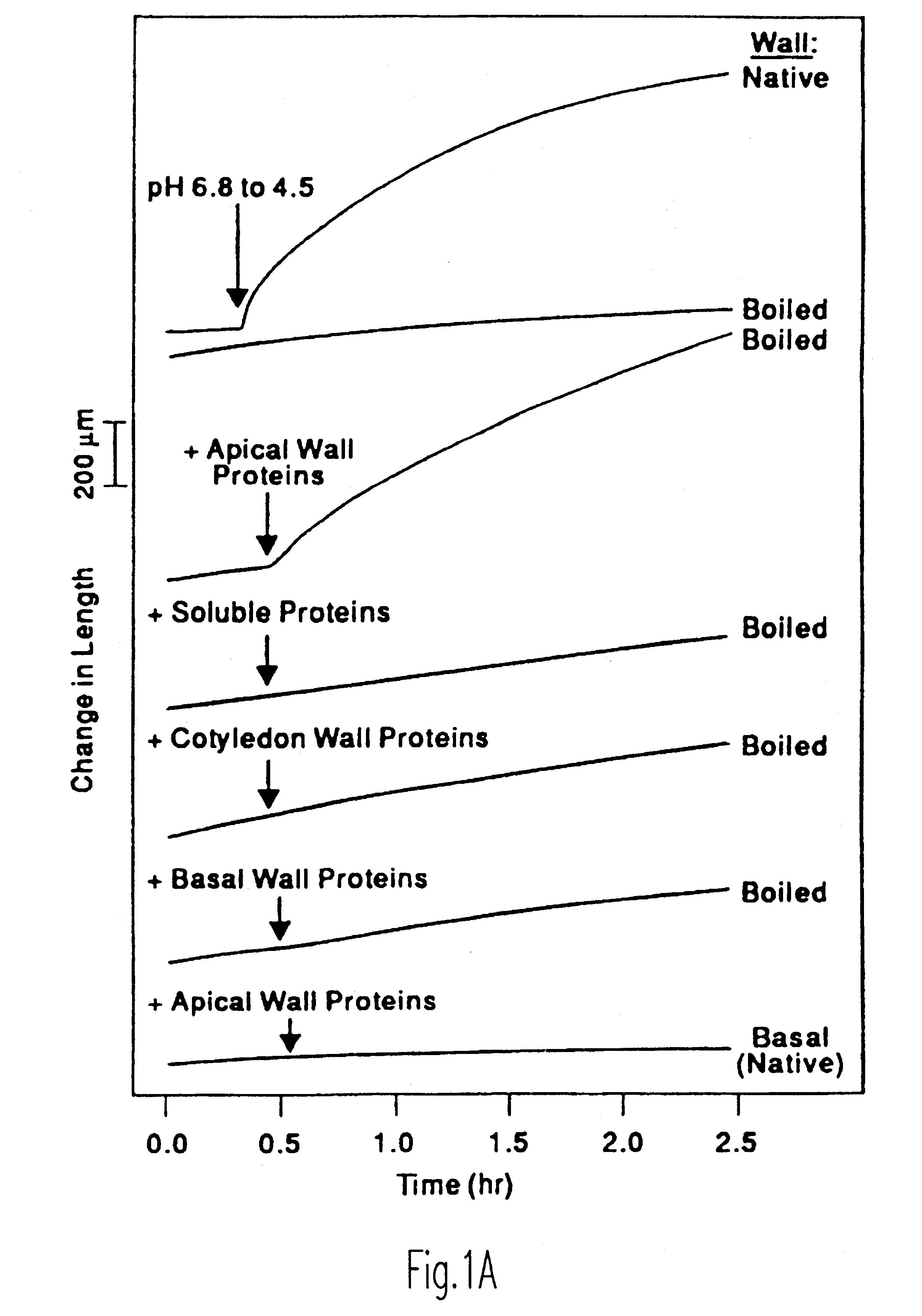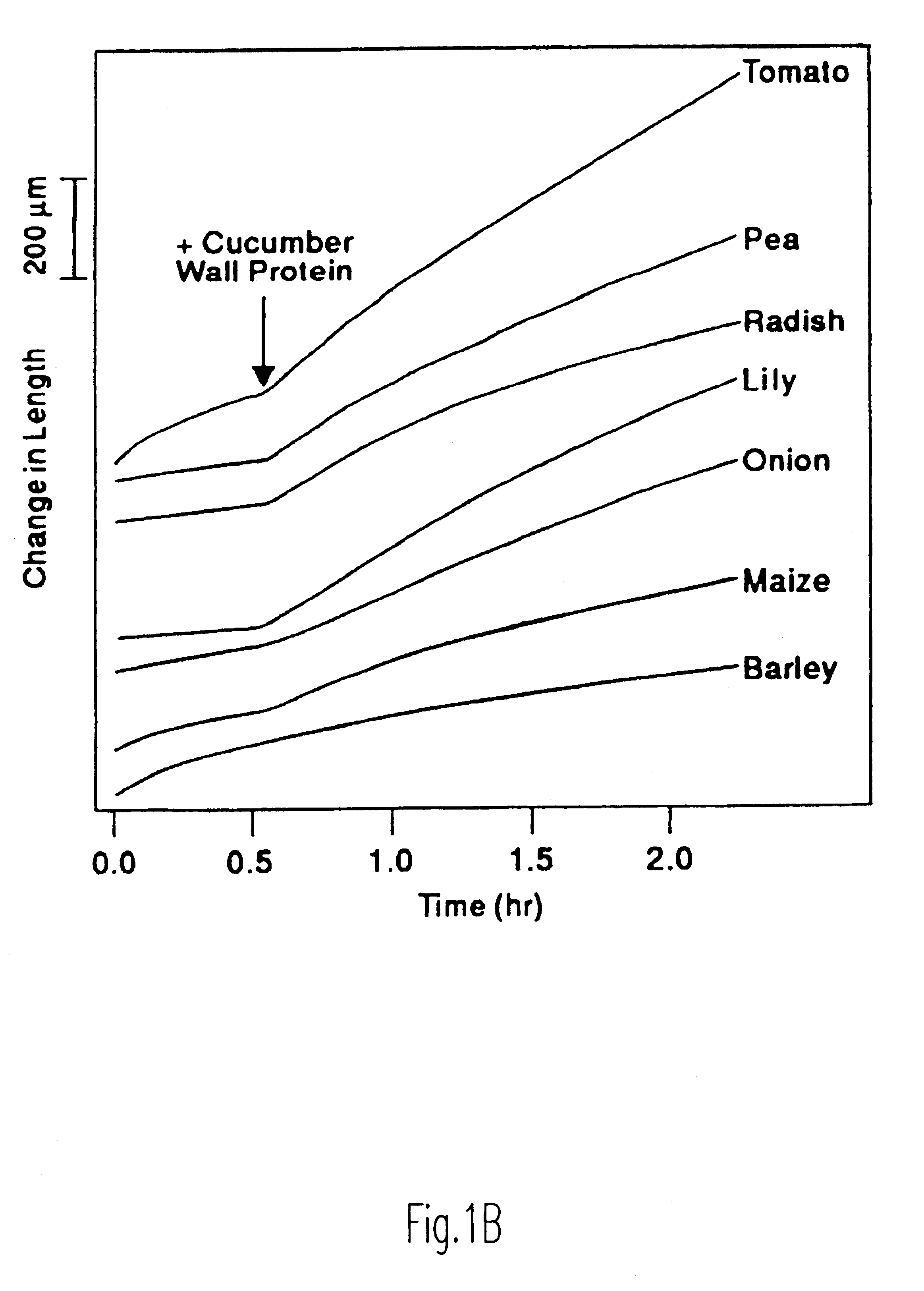Enhancement of accessibility of cellulose by expansins
a technology of expansins and cellulose, which is applied in the field of enhancement of accessibility of cellulose by expansins, can solve the problems of limiting the access of enzymes or chemicals to individual glucans, unable to recycle second types of papers, and lacking the major evidence in favor of wall-loosening enzymes as agents of growth control
- Summary
- Abstract
- Description
- Claims
- Application Information
AI Technical Summary
Problems solved by technology
Method used
Image
Examples
example 2
Isolation of expansins cEx-29 and cEx-30 from cucumber
Protein Extraction
Washed cucumber cell wall fragments (from 150-200 g of tissue) were extracted overnight in 20 mM Hepes, pH 6.8, 1 M NaCl at 4.degree. C. Cell wall fragments were filtered on Miracloth and the salt-solubilized fraction precipitated with ammonium sulfate (the activity precipitated between 20 and 60% saturation with [NH.sub.4 ].sub.2 SO.sub.4). The precipitate was desalted on a 7-mL column of Bio-Gel P2 (Bio-Rad Laboratories) into 50 mM sodium acetate, pH 4.5. Protein concentration was 2 to 4 mg / mL, estimated by Coomassie Protein Assay Reagent (Pierce, Rockford, Ill.).
For the comparison of soluble and wall associated proteins, 100 g of tissue was harvested and homogenized with 100 mL of 25 mM sodium acetate, pH 4.5, 1 mM EDTA. Wall fragments were filtered out and the remaining solution designated as the soluble fraction. Wall fragments were cleaned as described above, and then extracted in 200 mL of 20 mM Hepes, pH...
example 3
Isolation of expansins oEx-29 from oat
Protein Extraction.
For oat protein extraction, oat seedlings were rapidly cut under room lights and placed in ice water. The apical 2.5 cm (+ / -0.5 cm) of each coleoptile was then cut, separated from the primary leaf, and placed on ice while the other coleoptiles were harvested. About 500 coleoptiles were homogenized in 200 mL of 10 mM sodium phosphate, pH 6.0. In some instances the coleoptiles were collected in lots of 100-200 and frozen (-20.degree. C.) for 1 to 3 d prior to homogenization. The homogenate was filtered through a nylon screen (70 mm mesh), and the cell walls were collected and washed 4 times by resuspending in the homogenization buffer (300 mL) followed by filtration. lonically-bound proteins were extracted for at least 1 hour at 4.degree. C. with 50 mL of 1 M NaCl containing 20 mM Hepes (pH 6.8), 2 mM EDTA and 3 mM sodium metabisulfite. Wall fragments were removed by filtration or centrifugation and the wall proteins in the supe...
example 4
Preparation of expansin-like proteins from snails and snail feces.
Acetone powders of the visceral humps of Helix pometia were purchased from Sigma Chemical Company. Live snails (Helix aspersa) were purchased from NASCO. Protein solution was made by dissolving snail acetone powder (10 mg / ml) in 50 mM sodium acetate buffer, pH 4.5. Feces of Helix aspersa were dissolved in the same buffer.
PUM
 Login to View More
Login to View More Abstract
Description
Claims
Application Information
 Login to View More
Login to View More - R&D
- Intellectual Property
- Life Sciences
- Materials
- Tech Scout
- Unparalleled Data Quality
- Higher Quality Content
- 60% Fewer Hallucinations
Browse by: Latest US Patents, China's latest patents, Technical Efficacy Thesaurus, Application Domain, Technology Topic, Popular Technical Reports.
© 2025 PatSnap. All rights reserved.Legal|Privacy policy|Modern Slavery Act Transparency Statement|Sitemap|About US| Contact US: help@patsnap.com



